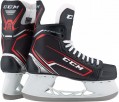Size
The boot sizes of the skates. One skate model can have a full
fixed size grid (
25,
26,
27,
28,
29,
30,
31,
32,
33,
34,
35,
36,
37,
38,
39,
40,
41,
42,
43,
44,
45,
46 size) and include both
kids skates and adults. And for models with
adjustable sizes(see "More features"), size ranges are indicated in this paragraph, while one model can be produced in several range options. For example, the designation "35-38, 39-42" means that the skates are available in two versions: one is adjustable from size 35 to 37, the second is from 39 to 42.
Boot material
The main material used in the outer trim of the boot.
—
Combined synthetics. Combination of different types of synthetic fibers. Specific materials are usually selected with the expectation of resistance to low temperatures and moisture; in general, the combined synthetics are durable, retain heat well, and also do not tend to stretch. At the same time, this material is relatively inexpensive, which makes it very popular, especially in pleasure and hockey skates (see "Skating style").
—
Genuine leather. Quite an expensive and prestigious material: the skin is durable, reliable, impervious to moisture and at the same time allows the foot to “breathe”, and such boots look stylish and solid. In general, this material is considered suitable mainly for figure skating (see "Skating style"), it is practically never found in skates for other purposes. Among the shortcomings of the skin, in addition to the price, one can note the need for special care: shoes must be thoroughly cleaned and treated with special products, otherwise wrinkles and cracks will appear on them.
—
Nylon. Nylon is well suited primarily for recreational and hockey skates: it has good strength and rigidity, combined with low weight. However, such material costs a little more than the same synthetics, and therefore is less common.
—
Artificial leather.... Material that imitates the appearance of genuine leather. Most popular in figure skating models. The quality of leatherette, usually, directly depends on the price category of skates: inexpensive varieties wear out rather quickly, and the most advanced ones are almost indistinguishable from genuine leather. In general, this material is quite soft, but weakly retains heat and does not absorb moisture.
— Plastic. Relatively inexpensive material, which can easily be given almost any colour. At the same time, different types of plastic can be used in modern skates — from inexpensive and relatively fragile to advanced and high-quality ones. So it is best to evaluate the quality of a plastic boot by the price category of skates.
— Composite. Composite is a material consisting of several dissimilar components that do not mix. The specific composition of such a material may vary. However, carbon fibre is most often used in skates — carbon fibre with a plastic filler. Such a material has high rigidity, it is extremely light and at the same time durable. Nonetheless, it is very expensive — and therefore is found only in certain models of premium hockey skates.Type of steel
A type of steel used in skate blades. Different grades of steel differ primarily in hardness and resistance to corrosion. In general, the harder the blades, the longer they last and the less often you have to sharpen them, but increasing the hardness reduces corrosion resistance and affects the cost. In addition, the quality of steel often depends not only on its type, but also on the price category of skates. Specific types can be:
—
Stainless. The most inexpensive and softest type of "skate" steel, which, however, can be used even in fairly advanced skates. Note that, despite the name, "stainless steel" is still not completely resistant to rust, and the blades still need to be wiped dry after use.
—
Alloy. Steel with special additives that improve hardness and some other properties. Somewhat harder than stainless steel and keeps sharpening longer, but it resists rust worse, is more demanding to care for, and is more expensive.
—
Carbon. Steel with a high carbon content is very hard and holds sharpening for a long time. On the other hand, such an alloy costs accordingly and requires careful maintenance, since it rusts easily from prolonged contact with moisture.
—
High carbon. Steel with a very high carbon content. The hardest and at the same time the most expensive variety, moreover, it is dif
...ficult to sharpen and sensitive to rust (however, in terms of the latter property, such steel almost does not differ from “ordinary” carbon steel).
